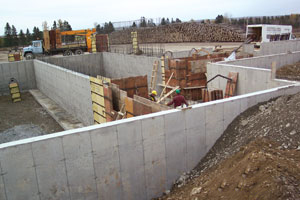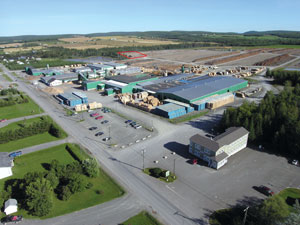
Project Report: Groupe Savoie Headed for Self-sufficiency
December 4, 2009
By Canadian Biomass
What started as an insurance policy to protect Groupe Savoie against the shrinking pulp and paper market has become the final step towards self-sufficiency.
What started as an insurance policy to protect Groupe Savoie against the shrinking pulp and paper market has become the final step towards self-sufficiency. The Saint-Quentin, New Brunswick-based forestry and forest products firm has brought together a fleet of sawmills and component plants in New Brunswick, Nova Scotia, and Tennessee over the past 31 years. Its latest addition is an $11-million plant in Saint-Quentin that will convert its leftover sawdust, bark, treetops, and branches into hardwood pellets and briquettes. Slated to begin production in April 2010, the plant will produce up to 55,000 tonnes of pellets and 8,000 tonnes of briquettes.
“We’ve had three major pulp and paper mills close down within 150 km of us,” recounts Roland Dufour, vice-president of sales and marketing. “It’s scary when you look at all that. We are basically a lumber company, but we need to get rid of the sawdust and the chips and the bark. Historically, it has been the paper industry that has used that.” Pellet production was one avenue for growth.

|
|
| When completed, Groupe Savoie's pellet plant will produce up to 55,000 tonnes of wood pellets from hard and soft maple and yellow birch residues from its sawmilling operations. – Photos: Groupe Savoie |
EUROPEAN MARKET
The pellets will make their way to Europe, where export sales of pellets and briquettes are estimated to reach more than $9 million. An estimated 80% of the pellets will be used for power generation and 20% for home and district heating. Strict environmental rules have forced Europeans to burn pellets rather than coal or oil, a reality that has put pellets at a premium. This is a switch that Groupe Savoie hopes Canadians will also embrace.
Europeans have a technology that requires only replacement of the oil burner with a pellet burner, which makes switching over relatively easy, explains Dufour. “There are a lot of possibilities. Years ago Europeans were using oil or coal, and now a lot of them have switched to pellets,” he says enthusiastically. “We are actively pursuing that type of technology and we are trying to convince the government that we can do that in Canada as well. It’s not an easy task, but if we keep on hammering them, sooner or later they’ll switch.”
The federal and New Brunswick governments have recently shown support for the ambitious project, announcing that they will invest $7 million in Groupe Savoie. The funding will allow the company to purchase and install equipment and provide training for the plant. The province is providing $5 million toward the project through a nonrepayable contribution and a loan. The federal government, through Atlantic Canada Opportunites Agency, is contributing $2 million.
The company’s pellet plant project continues to move forward. In late October 2009, the project was in the concrete-pouring stage. Dufour predicts that machinery will begin arriving in late November, and as of press time, looked to include: Hammer mills from Cardinal, rotary dryers from M-E-C, boilers from Wellons FEI, fire protection from Vipond, and an automated packaging system from Premier Tech. Finar Steel Buildings of Saint-Nicholas, Quebec, will handle building construction. The entire process will be self-sufficient. Using a Wellons FEI stepped grate combustor, the plant will burn bark to dry white wood in the M-E-C Rotary dryer for the pelletizing process (see more details on this system in our news section).
 |
|
| The new pellet plant will be built adjacent to Groupe Savoie’s pallet and component plants in Saint-Quentin, New Brunswick (indicated by red box). |
ROAD TO SELF-
SUFFICIENCY
Groupe Savoie’s industrial facilities comprise two sawmills, a pallet plant, a component plant, and dry kilns in Saint-Quentin; a component plant and a dry kiln in Kedgwick, New Brunswick; a pallet production and recycling plant in Moncton; a sawmill in Westville, Nova Scotia; and an assembly and finishing plant in Tennessee. The company’s sawmills produce 75 million thousand-bdft (175,000 m3) of hardwood lumber annually and more than two million pallets.
For the community of Saint-Quentin, the construction project means jobs. Twenty jobs are estimated for the plant, with more in forestry and trucking. For Groupe Savoie, the project means self-sufficiency. “The real advantage is that we have our own raw material. We do not have to rely on another industry or another mill that we don’t have control of to get the material,” says Dufour. “We are totally vertically integrated.” •
-Colleen Cross
Print this page